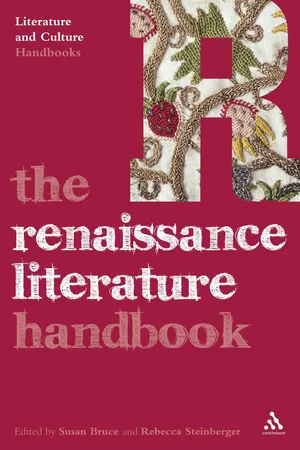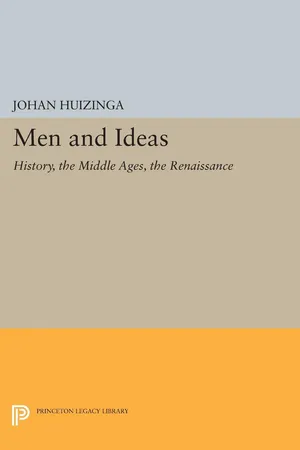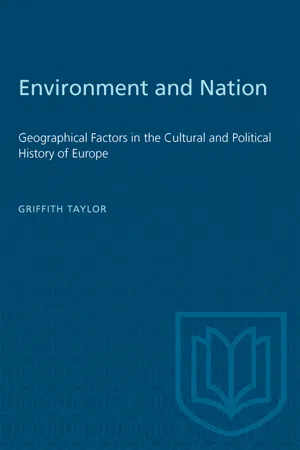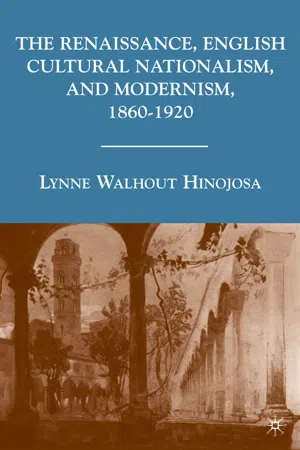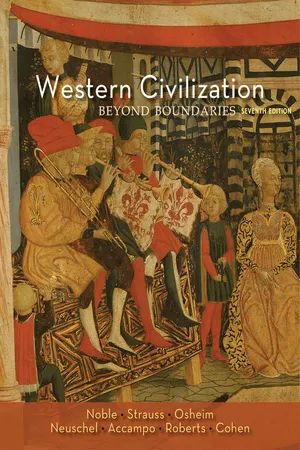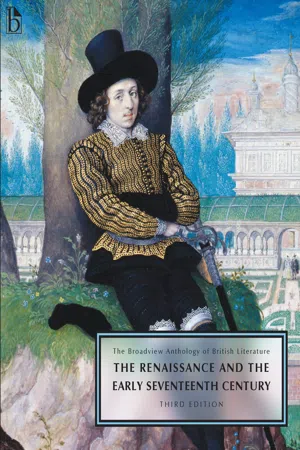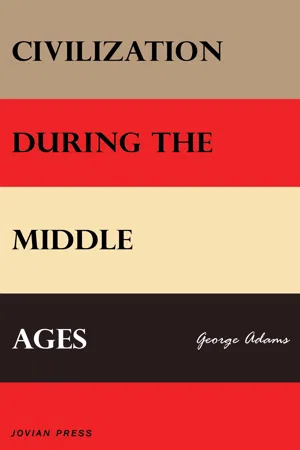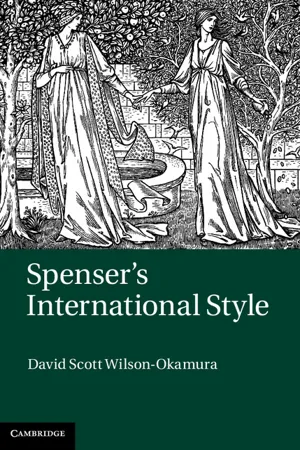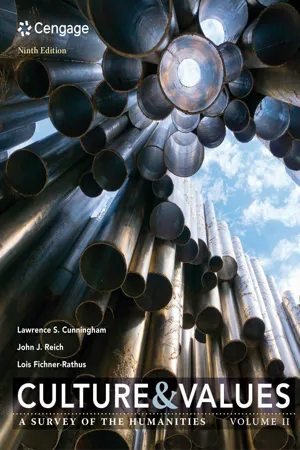Literature
Renaissance
The Renaissance was a cultural movement in Europe during the 14th to 17th centuries, characterized by a revival of interest in classical learning, art, and literature. It marked a shift from the medieval to the modern world, with a focus on humanism, individualism, and the exploration of new ideas. Renaissance literature often reflected these themes through works that celebrated human potential and the beauty of the natural world.
Written by Perlego with AI-assistance
Related key terms
1 of 5
9 Key excerpts on "Renaissance"
- eBook - PDF
- Susan Bruce, Rebecca Steinberger, Susan Bruce, Rebecca Steinberger(Authors)
- 2009(Publication Date)
- Continuum(Publisher)
Part I The Renaissance Period This page intentionally left blank The Historical Context of 1 English Renaissance Literature: From Conflict to Creativity William J. Kerwin Chapter Overview Health Crises and Body Conflicts: Plague and Pox 24 Intellectual Conflicts: Humanism and Modern Media 27 Religion and Conflict: The Reformation 29 Gender Conflict: Women in Their Places 31 Economic Conflict: Building a New Market World 33 Outward Conflict: Looking Outside England 35 Political Conflict: From Feudal Kingdom to Modern State 37 The English Renaissance produced what is perhaps the greatest literature in English history: the range and quality of its poetry, and most especially of its drama, surpass that produced in any other period. The extraordinary richness of the literature produced in the Renaissance might lead one to ask why some epochs nurture artistic creation so much more powerfully than others. What aspect or aspects of an historical moment enable the production of great writing? What is the relation between ideas and the history which surrounds them? There have been a number of different answers to these questions. Some have denied that history plays any significant part at all, insisting that great minds alone suffice to produce great literature. Others have claimed that art needs peace, and that the stability afforded by the end of the Wars of the Roses (which begins our period, with the accession of Henry VII) afforded the authors the time and space to write their plays and their poetry (and in some cases, even, their prose). Both of these views privilege the author (and the text) 23 over ‘history’ (or context), but the mid- twentieth century saw a challenge to that view of the relation between text, author and context. - eBook - PDF
Men and Ideas
History, the Middle Ages, the Renaissance
- Johan Huizinga(Author)
- 2014(Publication Date)
- Princeton University Press(Publisher)
The Renaissance came because people learned how to understand the spirit of the ancients, and its essential element was the imitation of classical art and literature. Some of the textbooks also made a small place for the art of printing and the discovery of America among the causes of the general revival. I am not sure which schoolbook it was whose chapters on the modern period are said to have begun with the confident opening sentence 'The rebirth of the human spirit dates from the discovery of firearms," a sentence that, well considered, is Marxism a outrance. But be that as it may, the opinion then current, that the imitation of antiquity was the alpha and omega of the Ren- aissance, has never been more than a secondhand simplification of the views of those whose minds cherished the concept of the Renaissance and brought it to maturity. Even Voltaire, we have seen, had a much broader view of the phenomenon of revival. If any one person must be made responsible for the school opinion, it would have to be Pierre Bayle. Now we have come to the full unfolding, beneath the hand of Jacob Burckhardt, of the concept of the Renaissance in all its rich, colorful aspects as a form of life far transcending the limits of historical study for its own sake. It is a fact that the great Swiss scholar was inspired by a The Problem of the Renaissance 255 seer whose hallucinated vision illuminated history as if with flashes of lightning: Jules Michelet. The year 1855 saw the appearance of Michelet's Histoire de France au XVIiime siicle, the seventh volume of his Histoire de France, with the subtitle Renaissance. Michelet's attitude toward the great cultural transformation was that of the Enlightenment, as it had merged into liberalism and was reflected in his brilliant mind. What the sixteenth century had brought was, to him just as much as to the rationalists of the eighteenth century, light—light in the barbaric darkness of the Middle Ages. - eBook - PDF
Environment and Nation
Geographical Factors in the Cultural and Political History of Europe
- Griffith Taylor(Author)
- 2019(Publication Date)
- University of Toronto Press(Publisher)
CHAPTER XI THE Renaissance IN TIME AND SPACE A. The Development and Spread of the Universities It is hardly possible to define in a few words what is meant by the Renaissance. It involved a period of time marked by a rapid evolu-tion of culture-but the time and the character of the culture differed considerably from place to place. It is this latter aspect of the prob-lem-the migration and modification of the Renaissance as it pro-gressed-which makes the geographical treatment of considerable interest. Throughout much of its development it is closely linked with Humanism and with the Reformation. It would be foolish, however, to look upon it as a factor in national differentiation of the same importance as language or religion . It was rather a phase in human progress which was largely-though not wholly-confined to the Western half of Europe; at any rate in the earlier, more significant stages of the Renaissance. Yet its roots are to be found in the South-east-and a later phase of its flowering is to be perceived in the North-east. In the present brief survey of the Renaissance, our attention will be confined mainly to two phases, first, the growth of a more liberal and modern frame of mind, which is labelled Humanism, and, secondly, the progress in the Arts will be illustrated by the develop-ment of architecture. Both subjects illustrate very clearly that shift of the area of notable social evolution from the Southeast to the West which marked the close of Medieval Times. It has already been stated that it is difficult to date the beginning or end of the Renaissance. Still there are considerable differences in its stages of development and it will be found helpful to consider these for a moment before discussing them separately. The following four periods seem to be fairly well-defined, at any rate in the areas including Italy, France, England and Germany. They are illustrated in the four maps (Figs. 48 to 51). - L. Hinojosa(Author)
- 2009(Publication Date)
- Palgrave Macmillan(Publisher)
The tension between high and low culture was also a dominant concern in late nineteenth- and early twentieth-century England. When Symonds wrote his volumes on the Renaissance in the 1870s and 1880s, English scholars debated whether to replace classical studies in the universities and public schools with a national study of literature in the vernacular and other “modern” subjects. Symonds believed that “the higher culture of the race” would still be grounded in humanism, but that “average stu- dents [would] probably require new methods of teaching the classics” because they had no “special vocation for literature and no aesthetic tastes” ( Renaissance 580). Embedded in interpretations of the histor- ical Renaissance is a dilemma of the late nineteenth century: the rela- tion of classicism to national culture, elitism to popularism. Despite the impossibility of escaping hermeneutic circles, it is instructive to trace through time the development of the Renaissance as a period concept, for one can see how various ideas and questions about nation, modernity, and culture become attached to it. The fol- lowing genealogy draws from, among other studies, three major works that trace the history of the Renaissance concept: Wallace Ferguson’s The Renaissance in Five Centuries of Historical Thought (1948), John Hale’s England and the Italian Renaissance (1954), and J. B. Bullen’s The Myth of the Renaissance in Nineteenth-Century Writing (1994). All three of these scholars agree that by the late nine- teenth century the Renaissance referred to a periodized segment of history, and that by the time of Symonds’s texts the concept of the Renaissance was naturalized in the English language. Because these and others have provided detailed accounts of the concept in England through the late nineteenth century, I outline only briefly the early trajectory here. Throughout its development the concept of the- eBook - PDF
Western Civilization
Beyond Boundaries
- Thomas F. X. Noble, Barry Strauss, Duane Osheim, Kristen Neuschel(Authors)
- 2013(Publication Date)
- Cengage Learning EMEA(Publisher)
Due to electronic rights, some third party content may be suppressed from the eBook and/or eChapter(s). Editorial review has deemed that any suppressed content does not materially affect the overall learning experience. Cengage Learning reserves the right to remove additional content at any time if subsequent rights restrictions require it. 356 Chapter 12 The Renaissance Chapter Summary ◆ ◆ How did Italians use classical values to deal with cultural and political issues? The Renaissance was a broad cultural movement that began in Italy in response to a series of crises in the early fourteenth century. It was a cultural and ideological movement based on the assumption that study and imitation of the past was the best method for reform and innovation in the future. The impulse for change arose from the belief, shared by thinkers from Petrarch to Machiavelli, that a great deal could be learned from study of the Roman past. This was the basis for humanistic innovations in language, history, and politics. Even revolutionary thinkers, such as Lorenzo Valla and Niccolò Machiavelli, began with the study of classical literature and history. ◆ ◆ What was “new” about Renaissance art? The same transformation is evident among the artists. Early in the fifteenth century, Florentines who experimented with perspective were intent on recovering lost Roman knowl- edge, and Michelangelo was praised not only for mastering but also for surpassing Roman norms. The artistic innovations of Italy were noted and valued throughout the Mediterranean and northern Europe. Artists like Albrecht Dürer combined their understanding of Italian art with northern ideas. Throughout Europe, art was an important component of religious and political culture. ◆ ◆ In what ways did humanism outside Italy differ from Italian humanism? Humanistic studies outside of Italy were less tied to public life. - Joseph Black, Leonard Conolly, Kate Flint, Isobel Grundy, Wendy Lee, Don LePan, Roy Liuzza, Jerome J. McGann, Anne Lake Prescott, Barry V. Qualls, Jason Rudy, Claire Waters(Authors)
- 2016(Publication Date)
- Broadview Press(Publisher)
The Renaissance was an age of artifice (“artificial” was during this period used exclusively as a term of praise), and much of the poetry of the 1580s and 1590s is given to imagery that is extravagant in its inventive- The Renaissance and the Early Seventeenth Century xci ness. Some of the extravagance is tongue-in-cheek, as is surely the case with Shakespeare’s evident lampooning in his early comedy Love’s Labor’s Lost of the verbal excess of the character Holofernes, whose “gift” is “a foolish extravagant spirit, full of forms, figures, shapes, objects, ideas, apprehensions, motions, revolutions: these are begot in the ventricle of memory, nourished in the womb of pia mater , and delivered upon the mellow-ing of occasion.” In his poetry of the later 1590s and of the early seventeenth century, Shakespeare tamed his earlier tendency toward extravagant cleverness, though he never abandoned artifice. Much the same may be said of Ben Jonson, who advocated “plain language” and told poets to take care of their style in writing: “Be not winding, or wanton with far-fetched descriptions,” he advised. Many of the most important poets of the early seventeenth century, however, aspired to new heights of inventiveness. Chief among these was John Donne. Donne’s early verse in particular often plays in elaborate fashion with extraordinary comparisons. It also twists and turns syntactically, mirroring in its form the surpris-ing paradoxes or contradictions conveyed in the sense of the lines. These sorts of images, drawing extreme comparisons, have come to be known as “conceits.” In some cases a conceit may be extended over several lines, or indeed a full poem.- eBook - ePub
- George Adams(Author)
- 2017(Publication Date)
- Jovian Press(Publisher)
THE Renaissance
..................WE HAVE NOW TRACED, AS resulting from the influence imparted by the crusades, great economic and political revolutions which changed the face of history, and brought the middle ages to a close so far as their influence reached. These two revolutions were hardly more than well under way when there began another, growing largely out of the conditions which they were producing, starting partly from the same general impulse which aided them, a revolution of even greater importance than they in its influence upon the characteristic features of our own time, if it is possible to measure the relative values of such movements—that intellectual and scientific transformation of Europe which we call the Revival of Learning, or the Renaissance.Each of these names expresses a great fact which was characteristic of the movement and which it is well to distinguish, the one from the other.There was a revival of learning. The conditions which prevailed in the earlier middle ages, and obscured the learning which the ancients had acquired, were changing rapidly, the effects of the Teutonic invasion were passing away. Conquerors and conquered had grown into a single people, and the descendants of the original Germans had reached the point where they could comprehend the highest results of the ancient civilization. New national languages had been formed, and literatures had begun, no longer ecclesiastical in authorship or theme but close to daily life. The stir of great events, and the contagion of new ideas in commerce and exploration and politics filled the air, and the horizon of men’s minds and interests was daily growing wider. It was impossible that many generations of these economic and political changes should go by before men began to realize that there lay behind them a most significant history, and that the men of the past had many things to teach them. When men became conscious of this the revival of learning began. - eBook - PDF
- David Scott Wilson-Okamura(Author)
- 2013(Publication Date)
- Cambridge University Press(Publisher)
The Renaissance was heir to this doctrine and conceived of itself in imitative language, as a rebirth of classical civilization. 32 And what was so great about that? We don’t usually ask this question, because it sounds rude, but also because (at the back of our minds) we suspect that the real answer would be embarrassing: that someone who devotes his life to studying obsolete literature is either an effete ninny (like Cecil Vyse) or a social-climbing snob (like Hyacinth Bucket). But Spenser was not a sissy, and Marlowe was not a toff. What they wanted from the old poets was not just status, it was power: in lyric, the classical authors’ power to charm; in epic, their power to command. How trusting! If the Middle Ages are still considered the Age of Faith, then the Renaissance should be called the Age of Faith in Language. The depth of this faith, not to say credulity, is shown by what happened to the educational system. After centuries of taking a back seat to logic, language became the queen of the sciences again and, in primary school, almost the only thing that anyone studied. Where the modern schoolboy learns half a dozen subjects, his Elizabethan counterpart studied only one, which today we should call classics. How was this justified? Morality was part of the answer: morality in the form of obedience. 33 But how much morality can one really learn from a pagan (like Cicero), a seducer (like Ovid), or a pederast (like Virgil)? It was a question that Christians had been asking themselves since St. Jerome. The other justification was style. The old styles were worth learning to imitate because they worked: because, by means of eloquence, the Greek and Roman orators really did civilize their countrymen and subdue their neighbors. 34 The style of their speeches and poems – what we may call the classical sound – was not just the sound of respectability then; it was also the sound of power. - eBook - PDF
Culture and Values
A Survey of the Humanities, Volume II
- Lawrence Cunningham, John Reich, Lois Fichner-Rathus, , Lawrence Cunningham, John Reich, Lois Fichner-Rathus(Authors)
- 2017(Publication Date)
- Cengage Learning EMEA(Publisher)
Copyright 2018 Cengage Learning. All Rights Reserved. May not be copied, scanned, or duplicated, in whole or in part. Due to electronic rights, some third party content may be suppressed from the eBook and/or eChapter(s). Editorial review has deemed that any suppressed content does not materially affect the overall learning experience. Cengage Learning reserves the right to remove additional content at any time if subsequent rights restrictions require it. 478 | CHAPTER 14 The High Renaissance in Northern Europe and Spain otherworldly nature of the upper canvas. The emotion is high pitched and exaggerated by the tumultuous atmosphere. This emphasis on emotionalism links El Greco to the onset of the Baroque era. His work contains a dramatic, the- atrical flair, one of the hallmarks of the 17th century. musIc As in the visual arts, the Renaissance produced major stylistic changes in the development of music, but in general, musical development in the Renaissance was marked by a less severe break with medieval custom than was the case with the visual arts. Although 16th-century European composers began to increase the complexity of their style, frequently using polyph- ony, they continued to use forms developed in the High Middle Ages and the Early Renaissance. In religious music, the motet remained popular, set to a religious text. Com- posers also continued to write madrigals (songs for three or more solo voices based generally on secu- lar poems). For the most part, these were intended for performance at home, and elaborate, interweav- ing polyphonic lines often tested the skill of the singers. The difficulty of the parts often made it necessary for the singers to be accompanied instrumentally. This increasing complex- ity produced a significant change in the character of madrigals, which were especially popular in Elizabethan England. None- theless, 16th-century musicians were recognizably the heirs of their 13th- and 14th-century predecessors.
Index pages curate the most relevant extracts from our library of academic textbooks. They’ve been created using an in-house natural language model (NLM), each adding context and meaning to key research topics.
